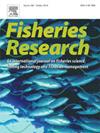Variable post-capture condition estimated by visual assessment for key recreational species discarded in a nearshore marine charter fishery off eastern Australia
IF 2.2
2区 农林科学
Q2 FISHERIES
引用次数: 0
Abstract
Many fish species caught in recreational fisheries are released after capture due to regulations or fisher preference. In regions where large proportions of the catch are released, assessing ‘post-capture survival’ (PCS) is essential for comprehensive stock assessments and sustainable management. Here we present a case study for the development and application of a simple semi-quantitative approach to provide ‘post-capture body condition’ (PCC) indices using visual assessment in a coastal boat-based angling fishery, providing an informative descriptive precursor to quantifying actual PCS. Assessment indices and scores were developed from published information on factors shown to affect PCS of the focal species, so that estimated PCC was indirectly related to survival. More than 2000 individuals of 18 species were visually assessed by trained observers prior to release and overall PCC estimated. For commonly released species, estimates of PCC were highly variable and primarily determined by the degree of observed barotrauma. Estimated PCC was highest for Bluespotted Flathead, Mahi Mahi, Yellowtail Kingfish and Pearl Perch, lower for Grey Morwong and Snapper, and lowest for Teraglin. For Grey Morwong and Teraglin, increasing capture depth also significantly decreased PCC. Body length and water temperature did not have a significant effect on the PCC of any species. Whilst true survival of each individual is not determined here, the approach described provides an efficient basic assessment of PCC which combines multiple factors into a single estimate providing an important descriptive precursor to inform future work using direct approaches to quantify actual PCS. Such studies may also improve the utility of this metric by defining the functional relationship between PCC scores and PCS. This approach can be easily implemented as a preliminary standard practice where there is an intention for PCS data to be collected to evaluate the effectiveness of management, or for stock assessments to account for indirect fishing mortality.
在澳大利亚东部近岸海洋租船渔业中,通过目视评估对主要休闲物种丢弃的可变捕获后条件进行估计
由于法规或渔民的喜好,许多在休闲渔场捕获的鱼类在捕获后被释放。在大量捕捞量被释放的区域,评估“捕捞后存活”(PCS)对于全面的种群评估和可持续管理至关重要。在这里,我们提出了一个案例研究,用于开发和应用一种简单的半定量方法,利用视觉评估在沿海渔船渔业中提供“捕获后身体状况”(PCC)指数,为量化实际PCS提供了一个信息丰富的描述性前兆。根据已发表的影响焦点种PCS的因素的信息制定了评估指标和得分,因此估计的PCS与生存间接相关。训练有素的观察员在放生前对18个物种的2000多只进行了视觉评估,并估计了总体PCC。对于通常释放的物种,PCC的估计是高度可变的,主要取决于观察到的气压创伤的程度。估计PCC最高的是蓝斑平头鱼、Mahi Mahi、黄尾王鱼和珍珠鲈,较低的是灰鱼和鲷鱼,最低的是天龙鱼。增加捕获深度也显著降低了灰狼和龙狼的PCC。体长和水温对各物种的PCC均无显著影响。虽然这里没有确定每个个体的真实存活率,但所描述的方法提供了一个有效的PCC基本评估,它将多个因素结合到一个估计中,为使用直接方法量化实际PCS的未来工作提供了重要的描述性先驱。这样的研究也可以通过定义PCC分数和PCS之间的函数关系来提高这一指标的效用。如果打算收集PCS数据以评价管理的有效性,或进行种群评估以说明间接捕捞死亡率,则可以很容易地将这种方法作为初步标准做法加以执行。
本文章由计算机程序翻译,如有差异,请以英文原文为准。
求助全文
约1分钟内获得全文
求助全文
来源期刊

Fisheries Research
农林科学-渔业
CiteScore
4.50
自引率
16.70%
发文量
294
审稿时长
15 weeks
期刊介绍:
This journal provides an international forum for the publication of papers in the areas of fisheries science, fishing technology, fisheries management and relevant socio-economics. The scope covers fisheries in salt, brackish and freshwater systems, and all aspects of associated ecology, environmental aspects of fisheries, and economics. Both theoretical and practical papers are acceptable, including laboratory and field experimental studies relevant to fisheries. Papers on the conservation of exploitable living resources are welcome. Review and Viewpoint articles are also published. As the specified areas inevitably impinge on and interrelate with each other, the approach of the journal is multidisciplinary, and authors are encouraged to emphasise the relevance of their own work to that of other disciplines. The journal is intended for fisheries scientists, biological oceanographers, gear technologists, economists, managers, administrators, policy makers and legislators.
 求助内容:
求助内容: 应助结果提醒方式:
应助结果提醒方式:


